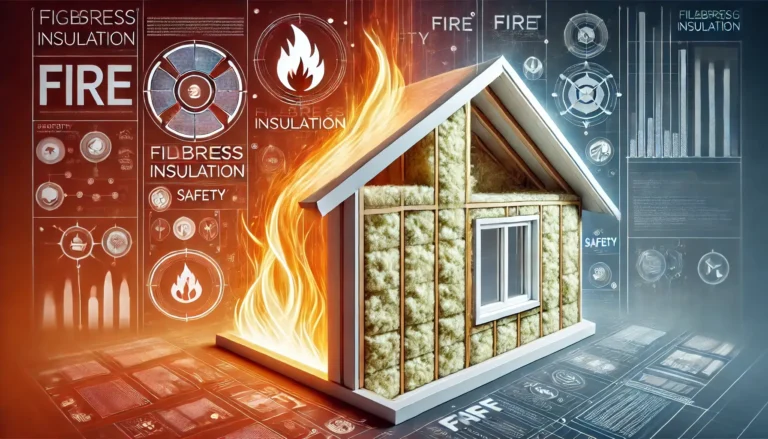Whether accidently or unconsciously, if you eat or inhale insulation, it may lead to serious consequences. Ingesting or Inhaling insulation materials like fiberglass insulation or spray foam insulation is dangerous and can cause immediate discomfort. Fiberglass particles, with their tiny glass fibers, can irritate the digestive system and lead to symptoms like throat irritation, nausea, or vomiting.
Spray foam insulation contains chemicals that may cause toxic or allergic reactions if swallowed. According to studies, exposure to fiberglass is linked to respiratory issues and digestive tract irritation, making ingestion a serious concern.
Dr. Susan M. Buchanan, a public health expert specializing in environmental health, stresses that individuals who accidentally ingest insulation should seek medical attention immediately.
“Although the body may naturally expel minor insulation particles, serious cases can result in severe irritation to the digestive system and potential internal injuries, particularly with fiberglass insulation”.
Considering this, Medical attention should be sought if symptoms worsen, including difficulty breathing or persistent abdominal pain, as an allergic reaction to insulation is possible.
Inhaling vs. Eating Insulation: Expert Insights and Research
Before you rush to any medical aid, note down insulation inhalation and eating/ingesting insulation can lead to all different reactions and consequences. Both inhaling and eating insulation present serious health risks, but the affected body systems differ significantly.
Inhaling Insulation
When insulation, especially fiberglass insulation, is inhaled, tiny fiberglass particles enter the respiratory system, leading to inflammation, coughing, and long-term risks like asthma. A study published in Environmental Health Perspectives found that repeated exposure to fiberglass in lungs may result in chronic respiratory conditions, including bronchitis and lung scarring.
Ingesting Insulation
Eating fiberglass insulation affects the digestive system, causing irritation in the mouth, throat, and stomach. According to experts from the American College of Gastroenterology, ingestion of insulation materials can lead to nausea, vomiting, and abdominal pain, with rare cases causing internal injury.
The key difference lies in how each form of exposure affects the body: inhalation harms the lungs and airways, while ingestion targets the digestive tract. Immediate medical attention is essential for both scenarios.
What Happens If You Eat Insulation: Understanding the Risk & Consequences
Here’s a structured table highlighting the types of insulation and their associated health risks when ingested or inhaled:
Insulation Health Risks Comparison
| Type of Insulation | Main Composition | Health Risks if Ingested | Health Risks if Inhaled | Common Symptoms |
|---|---|---|---|---|
| Fiberglass Insulation | Tiny glass fibers | Irritation in the mouth, throat, and digestive tract | Respiratory irritation, potential lung damage | Nausea, vomiting, coughing, throat irritation |
| Spray Foam Insulation | Isocyanates, chemical compounds | Chemical burns, potential toxicity | Breathing difficulties, chemical inhalation risks | Difficulty breathing, chest pain, chemical burns |
| Cellulose Insulation | Recycled paper treated with borates | Minor digestive irritation | Dust inhalation, potential for lung irritation | Stomach pain, coughing, shortness of breath |
| Mineral Wool Insulation | Slag wool, rock wool | Gastrointestinal irritation, low toxicity | Respiratory inflammation, long-term lung damage | Coughing, sore throat, abdominal discomfort |
| Foam Board Insulation | Polystyrene or polyurethane | Chemical reaction in stomach, potential blockage | Toxic inhalation, respiratory complications | Nausea, difficulty breathing, chemical irritation |
| Glass Wool Insulation | Fine glass fibers | Digestive tract irritation, possible internal injury | Lung inflammation, chronic respiratory problems | Coughing, throat soreness, abdominal pain |
Fiberglass Insulation
Composed of tiny glass fibers, fiberglass is commonly used for thermal insulation. Exposure requires protective gear such as gloves, masks, and goggles to avoid skin and lung irritation.
Health Risks:
- Ingestion: Irritation in the mouth, throat, and digestive tract.
- Inhalation: Causes fiberglass in lungs, leading to coughing, difficulty breathing, and potential long-term respiratory issues.
Spray Foam Insulation
Made of chemicals like isocyanates, spray foam expands and hardens upon application. It requires protective measures like full-body suits and respiratory masks due to potential toxic exposure.
Health Risks:
- Ingestion: Chemical burns and potential toxicity.
- Inhalation: Causes breathing difficulties, chest pain, and possible damage to the respiratory system.
Cellulose Insulation
Composed of recycled paper treated with borates, cellulose is eco-friendly but dusty. Workers should wear masks to avoid inhaling fibers.
Health Risks:
- Ingestion: Minor digestive irritation.
- Inhalation: Causes coughing, sneezing, and shortness of breath due to dust particles.
Mineral Wool Insulation
Made from slag wool or rock wool, this material is fire-resistant. Exposure requires wearing gloves and respiratory protection to prevent skin irritation and inhaling fibers.
Health Risks:
- Ingestion: Stomach pain and gastrointestinal irritation.
- Inhalation: Causes throat soreness, coughing, and long-term lung damage.
Foam Board Insulation
Based on polystyrene or polyurethane, foam board insulation offers rigid thermal protection. Handling requires gloves and masks due to potential chemical exposure.
Health Risks:
- Ingestion: May cause blockages in the digestive system and chemical reactions.
- Inhalation: Toxic fumes can cause respiratory complications and chest tightness.
Glass Wool Insulation
Similar to fiberglass, glass wool is made from fine glass fibers. Full-body protection and masks are essential to avoid direct contact and inhalation.
Health Risks:
- Ingestion: Digestive tract irritation and potential internal injuries.
- Inhalation: Lung inflammation, coughing, and chronic respiratory issues.
Immediate Do’s and Don’ts After Insulation Ingestion
Ingesting insulation can pose serious health risks, particularly with materials like fiberglass insulation or spray foam insulation. Immediate actions are crucial to minimize potential damage to the digestive system. Medical experts strongly advise against taking actions that may worsen the situation. A study in the Journal of Clinical Toxicology emphasizes the importance of rapid medical intervention to reduce the risk of long-term damage.
Do’s:
- Seek Immediate Medical Attention: Contact a healthcare provider or visit the emergency room to receive appropriate care. Early intervention can help reduce harmful effects.
- Drink Water: While waiting for medical help, drinking water can help dilute the material in the stomach and reduce irritation, but do not attempt to induce vomiting unless instructed by a doctor.
- Avoid Further Exposure: Move away from the source of insulation to prevent inhalation of fiberglass particles or chemicals.
Don’ts:
- Do Not Induce Vomiting: According to toxicologists, inducing vomiting can cause further damage by bringing insulation fibers back up through the esophagus, leading to throat and respiratory irritation.
- Avoid Eating or Drinking Anything Acidic: Acids can worsen the chemical reaction in the stomach, particularly with spray foam insulation. Stick to water.
- Do Not Delay Medical Help: The longer the exposure, the higher the risk of severe consequences such as gastrointestinal damage or respiratory issues if fibers are inhaled.
Can Breathing in Insulation Kill You?
Consequences leading to death are very rare. While breathing in insulation particles, particularly fiberglass or mineral wool, is rarely fatal, it can lead to serious health risks.
Studies from the American Journal of Respiratory and Critical Care Medicine indicate that long-term exposure to fiberglass in lungs or other insulation materials can cause chronic respiratory conditions like pulmonary fibrosis, severe respiratory problems, and even lung damage.
Symptoms such as coughing, difficulty breathing, and chest tightness can escalate over time, especially without medical intervention. Though death is uncommon, prolonged inhalation of insulation fibers can lead to significant and irreversible lung issues, particularly in high-exposure environments.
Long-Term Health Impacts and Medical Treatment
Long-term exposure to insulation materials, whether through inhalation or ingestion, can lead to significant health problems. Eating insulation can cause ongoing damage to the digestive system, while inhaling insulation particles, including fiberglass or mineral wool, may lead to chronic respiratory issues.
A study published in the Journal of Clinical Toxicology highlights that insulation poisoning can result in prolonged symptoms such as abdominal pain, internal irritation, and in severe cases, organ damage. For inhalation, conditions like chronic coughing, difficulty breathing, and even lung inflammation can develop over time.
Medical Treatment Options:
- Inhalation Treatment: Doctors may prescribe inhalers or anti-inflammatory medications to relieve respiratory system issues.
- Ingestion Treatment: For accidental insulation ingestion, treatments may involve antacids or medical procedures to remove particles, depending on the severity.
Frequently Asked Question
Can fiberglass kill you if you eat it?
No, eating fiberglass is unlikely to be fatal, but it can cause severe digestive system irritation, abdominal pain, and other health problems. Immediate medical attention is necessary to avoid complications.
Is insulation toxic?
Certain types of insulation, like fiberglass and spray foam, can release harmful particles or chemicals if ingested or inhaled, leading to potential respiratory or digestive issues. Proper safety measures are essential.
Can insulation make you sick?
Yes, exposure to insulation materials can cause symptoms like coughing, skin irritation, and respiratory problems. Ingestion may lead to nausea, vomiting, or other health risks.
Is insulation bad for you?
Insulation itself is not harmful when properly installed, but direct contact or inhalation of its fibers, such as fiberglass, can cause health issues, especially with long-term exposure.
What happens if you eat insulation?
Eating insulation can lead to irritation of the digestive tract, causing symptoms like abdominal pain and nausea. Immediate medical help is necessary to manage any potential health effects.










